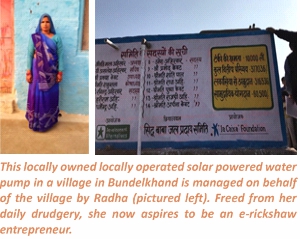|
Building Atma-Nirbhar Micro Enterprises
The Indian
government announced stimulus packages under the Atma-Ni Definitions thus reflect a certain irony of being ‘atma-nirbhar’ (independence / agency) especially as they create conditions for the marginalisation of informal rural enterprises. These enterprises according to Development Alternative’s experience and estimates indicate that they have a turnover of INR 2 to 3 lakhs. They are also the ones that have trouble accessing state support – for instance the promised collateral free loans by state agencies like MUDRA. MUDRA has a scheme for providing loans for up to INR 10 lakhs (collateral-free), but in reality, their paperwork and due diligence processes act like bottlenecks. Disbursement data of these loans indicate that they prefer to provide loans to units with at least some collateral or infrastructure. Many micro-enterprises are thus forced to borrow from Micro-Finance Institutions at high interest rates of 18 percent, which prevents them from investing in their enterprise growth for a long-time. Such moves perpetuate perceptions that informal micro-enterprises are risky credit ventures, narrowing their possibilities to be atma-nirbhar. Data from our Self-Help Group (SHG) Federation run Micro-Credit Facility, in contrast indicates that rural micro-enterprises have a healthy repayment record of 98 percent. These facilities are thus filling much needed gaps at the rural level for enterprises to access low credit amounts. Their efforts are upheld by regional enterprise coalitions in our geographies which allow entrepreneurs and stakeholders, including financial institutions, to discuss and jointly figure out solutions to credit barriers. With the pandemic and its economic effects, youth entrepreneurs on a virtual coalition in Mirzapur, raised the issue of low-barrier credit access and discussions are underway to arrive at a commonly agreeable solution. In Bundelkhand, one of India’s poorest regions in Central India, the Micro-Credit Facility already responded with widening of credit repayment windows without any added costs. Digital services are another leverage point that can over time potentially reduce the barriers for enterprise support, while providing an innovative enterprise model for youth entrepreneurs. Common Service Centres (CSCs) in Bundelkhand and Mirzapur are now functioning as information kiosks. During the lockdown, these kiosks were portals for village communities to access state support. Pre and post lockdown, they were (are) key portals for entrepreneurs to access business loans. For the youth entrepreneurs who run these centres, running an information kiosk provides them with a wider mission of enhancing entrepreneurial and capacity building support in their local areas while being an emergent sector opportunity. They earn a profit of over INR 200,000, 90% above Common Service Centres average across India2. These kiosks are now being scaled through the IMEDF programme to provide critical enterprise development services. Nodes like the information kiosks, coalitions and Micro-Credit Facility rooted in local economies show evidence of emergence of atma-nirbhar micro-enterprises like e-rickshaws, vermi-compost manufacturing, locally-owned, locally operated solar water pumps and now face masks (among others). Policy prescriptions can learn from such evidence of ground support, by tuning into local realities to enable success to spread. ■
Endnotes:
Vrinda Chopra
|
 rbhar Bharat
Abhiyaan. These supportive measures, however, are offset by
contradictory moves of changes to definitions of micro-enterprises. The
new micro-enterprise definition that has come through with the relief
package lumps a wider range of micro-enterprises, revealing their stark
detachment from local realities. The definition sees a micro-enterprise
as one with an investment of about INR 1 crore and a turnover five times
of the investment at approximately INR 5 crore (or less), while official
census data (which is also dated) says that on an average
micro-enterprises have a turnover of INR 41 lakhs1.
rbhar Bharat
Abhiyaan. These supportive measures, however, are offset by
contradictory moves of changes to definitions of micro-enterprises. The
new micro-enterprise definition that has come through with the relief
package lumps a wider range of micro-enterprises, revealing their stark
detachment from local realities. The definition sees a micro-enterprise
as one with an investment of about INR 1 crore and a turnover five times
of the investment at approximately INR 5 crore (or less), while official
census data (which is also dated) says that on an average
micro-enterprises have a turnover of INR 41 lakhs1.